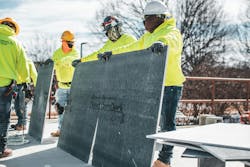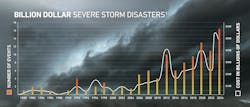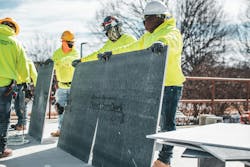Is your roof designed for hard-hitting hail?
Key Highlights
- How do you protect your assemblies and your reputation against forces you can’t control?
- Third-party organizations are calling for the roofing industry to implement stronger roofing systems.
- Help your designs for resilient roofing systems stay intact.
It’s no secret that extreme weather in the U.S. is on the rise. Billion-dollar severe storms have been steadily increasing in frequency since the 1980s1. In some regions, 2-inch-plus hail is an annual event. For the roofing industry, the challenge is clear: How do you protect your assemblies and your reputation against forces you can’t control?
Storm damage costs in the U.S.
Very large hailstones can fall at up to 100 mph, damaging cars, homes and commercial buildings in just a few minutes. Severe storms also bring lightning, high winds and tornadoes. All four can create catastrophic results, but hail consistently accounts for more than 50% of annual severe storm losses in the U.S.2 With total losses exceeding $46B in 2024, the cost of hail damage is staggering1.
Design your commercial roofs for impact
This is why more third-party organizations are calling for the roofing industry to implement stronger roofing systems for commercial low-slope buildings. Depending on your design intent and geographic location of your project, you may want to specify a cover board that helps protect against repeated hail strikes. DensDeck® StormX® Prime Roof Board was the first gypsum cover board to be FM classified for Very Severe Hail (VSH) in approved single-ply assemblies. It has double the flexural and compressive strength of the original DensDeck® Roof Board. This gives you enhanced protection against impact from foot traffic and flying debris, wind uplift and moisture. It also helps relieve static pressure caused by the weight of rooftop equipment.
Get our guide to commercial roofing for extreme weather
For more information on the rise of severe weather, including real-world damage examples, check out our guide, Commercial Roofing for Extreme Weather. This must-have resource on resilient rooftop design elaborates on FM Global’s testing and compares common membrane and cover board options. You can even share it with building owners and project leads to help communicate why you’ve made certain decisions regarding material specs. The goal is to help your designs for resilient roofing systems stay intact.
[1] NOAA National Centers for Environmental Information (NCEI) U.S. Billion-Dollar Weather and Climate Disasters (2025). https://www.ncei.noaa.gov/access/billions/, DOI: 10.25921/stkw-7w73
[2] https://capeanalytics.com/resources/growing-hail-claims/
Sponsored by:




